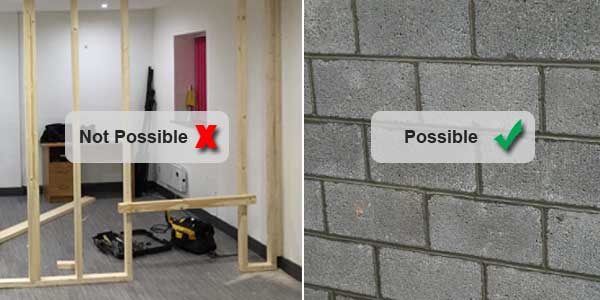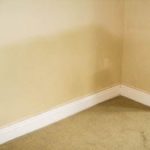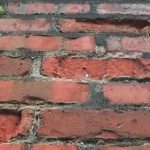The DIY Fix is reader supported. When you buy after clicking a link on our site, we may earn an affiliate commission.
Rising damp is a common form of damp in UK homes. It is the result of moisture from the ground traveling up through your masonry and entering your property.
This usually happens because of issues with your damp proof course (DPC). Although it can also happen in cavity walls where rubble and debris block the cavity above the DPC. This allows moisture to bridge across into your home completely bypassing the damp proof course.
Rising damp on internal walls is far less common. You are more likely to have this issue with external walls. This can cause damage to the internal side of an external wall (inside your property). But more often than not, rising damp will occur on a wall where one side is outside facing.
The only time an internal wall is at risk of rising damp, is if it is a load bearing wall and runs right down to the foundation. If this is the case, then there is potential for water to wick up into the property.

Why internal partition walls don’t get rising damp
Most walls inside your property will be internal partition walls. These are walls that determine the layout of your property and divide individual rooms.
This type of wall will usually be non-load bearing, they are just there to create the internal layout of the property.
Because of this, they have no contact with the ground below your property and cannot suffer with rising damp.
Partition walls can be made of a variety of materials. Some of the more common in UK homes are bricks, timber stud work, and sometimes metal stud work.
Stud walls made from wood, are the most common in modern properties. This is because they are easier and faster to construct. They are also usually cheaper to install. This is from both a materials and labour perspective, when compared with brick.
If a wall is load bearing it will often be made with blocks. So, if you live in a relatively modern home, it should be quite easy to determine if a wall is load bearing or a stud partition.
In older homes brick partitions can be more common, this will mean it may be less obvious.
Other ways to identify load bearing walls
A couple of things to look for when trying to identify load bearing walls are:
- Walls that span multiple floors. If a wall on the bottom floor, has another wall directly above it, then it is almost definitely load bearing.
- Large walls in the centre of your home or near chimney breasts. These are often spreading load from upper floors and the roof.
- Look for walls that appear larger or thicker than other internal partition walls.
- Do you have crawl space? If you can access the area below your ground floor you will be able to see walls that travel all the way to your foundations.
- Does your home have a cellar or basement? Again, if walls down there have walls above, they are probably load bearing. They are also below the DPC, so if you haven’t tanked your cellar it could be damp and allowing moisture to rise.
In all modern homes, according to building regulations, any internal wall that is built on load bearing foundations, will be equipped with a DPC, at approximately 150mm above ground level.
Installing a DPC has been mandatory in London since around 1875. This was rolled out to the rest of the country shortly after.
Therefore, if your property was built after this time, it will almost certainly have had a DPC. For property built before this, they may never have had one in the first place
If rising damp is present, then it is highly likely that your damp proof course has failed (or never existed) and will need replacing. One of the most common ways to do this is via damp proof injection creams.
Fixing rising damp on internal load bearing walls
If you have confirmed an internal wall is in contact with the foundations, and the wall is suffering from rising damp, then you have two options
- You can try to fix the problem yourself with a DIY damp course injection kit.
- Or you can hire a professional.
The main thing to consider, is the extent of the job. The wall will need plaster removing, this will usually be up to around 1 meter in height. It will also involve the removal of skirting boards.
In the worst-case scenario, there may be issues with other timber, such as floorboards, or even floor joists.
The goal at this point, is to remove any building materials that are holding moisture. Then once the new DPC is injected, this will all need replacing and making good.
If you are a confident and competent DIY expert, or if you have some building knowledge then you may be able to do the work yourself.
If not, it is probably best to hire a professional damp proofing company. The best thing about hiring a professional, is the job will be done correctly and will usually come with a guarantee.
Ideally, you should get multiple quotes to ensure you get the best possible price.
A good way to do this is via a comparison site that rates and reviews local damp proofing companies. The advantage of this, is you can find reliable damp companies with good customer reviews, at very reasonable prices.
To see our favourite damp proofing comparison site, and get up to 5 local quotes Click Here
What if it’s not rising damp?
If the damp problem is on an internal partition wall, then there can only be a few causes:
- Condensation – this is the most common form of damp and mould in UK homes. It is slightly less common on internal walls. This is because they are usually warmer than the external walls in the same property.
Moisture in the air will usually be attracted to, and condense on, the coldest surfaces. However, it can still happen, particularly behind furniture where air circulation is poor. - A leak of some kind – This could be due to leaking pipes, radiators, utilities etc. Look around for anywhere that water or moisture could potentially be coming from.
If you have exhausted all avenues and still can’t find the cause, then it is time to call in a professional.
Click here to get in touch with up to 5 local damp proofing experts
Conclusion
Rising damp on internal walls is less common, but it is possible. It can only affect specific walls inside your home, so you will need to do some investigation.
Hopefully, the tips in this article will help you to get to the bottom of the problem.




